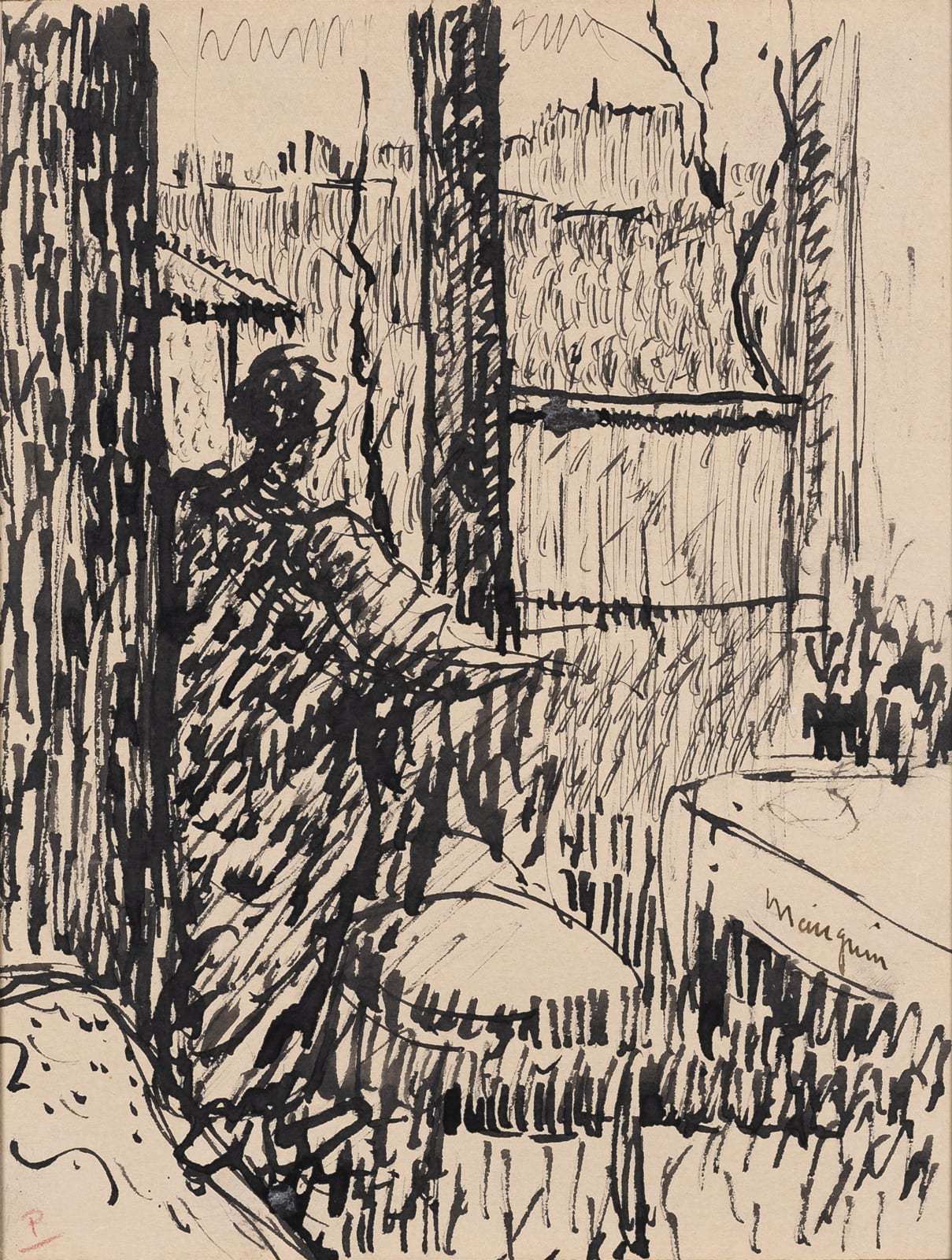Henri Manguin
Jeanne à la fenêtre, rue Boursault, 1903
Chinese ink on paper
8 1/4 x 6 1/4 in, 21 x 16 cm
Signed lower right
A founding member of the Fauves, Manguin studied under Gustav Moreau at École des Beaux-Arts in Paris alongside Matisse and Marquet from 1894 to 1897. In 1899 Manguin married Jeanne...
A founding member of the Fauves, Manguin studied under Gustav Moreau at École des Beaux-Arts in Paris alongside Matisse and Marquet from 1894 to 1897. In 1899 Manguin married Jeanne Marie Carette - who is depicted in this drawing - and they moved to a house on rue du Boursault in Paris, building a studio in its garden. The studio quickly became a gathering place for Manguin’s friends and fellow artists Matisse, Marquet, Camoin, Puy and Derain.
The year this drawing was created - 1903 - Manguin began lending his studio to Matisse and Marquet when they wanted to paint a model as they did not have their own spaces. These group working sessions continued for many years, becoming more frequent in the winters of 1904 and 1905, culminating in the infamous 1905 Salon d’Automne where the Fauves were ‘formed’.
Jeanne was Manguin’s muse, inspiration and primary model until 1931. Some of Manguin’s finest paintings are of his wife, including ‘The Prints’ from 1905 - now in Museo Thyssen-Bornemisza, Madrid - in which Jeanne is the model for both figures. In this drawing, Jeanne is depicted by the window of their Boursault street home. Manguin’s strong overlapping lines and cross hatching captures the scene in a flurry of activity, with the clearly defined outlines and wild curves of the trees relating to his later paintings.
Manguin enjoyed considerable success while he was alive; in 1904 he exhibited with the Galerie Berthe Weille, one of Picasso’s first dealers, and in 1906, the famous dealer, patron and collector of art, Ambroise Vollard bought 150 of his works outright. Then in 1907, the Galerie Eugene Druet held their first solo show of his work and continued to support him from thereon. Manguin’s works can now be found in every major institution such as MoMA, New York and Musée d’Orsay, Paris.
The year this drawing was created - 1903 - Manguin began lending his studio to Matisse and Marquet when they wanted to paint a model as they did not have their own spaces. These group working sessions continued for many years, becoming more frequent in the winters of 1904 and 1905, culminating in the infamous 1905 Salon d’Automne where the Fauves were ‘formed’.
Jeanne was Manguin’s muse, inspiration and primary model until 1931. Some of Manguin’s finest paintings are of his wife, including ‘The Prints’ from 1905 - now in Museo Thyssen-Bornemisza, Madrid - in which Jeanne is the model for both figures. In this drawing, Jeanne is depicted by the window of their Boursault street home. Manguin’s strong overlapping lines and cross hatching captures the scene in a flurry of activity, with the clearly defined outlines and wild curves of the trees relating to his later paintings.
Manguin enjoyed considerable success while he was alive; in 1904 he exhibited with the Galerie Berthe Weille, one of Picasso’s first dealers, and in 1906, the famous dealer, patron and collector of art, Ambroise Vollard bought 150 of his works outright. Then in 1907, the Galerie Eugene Druet held their first solo show of his work and continued to support him from thereon. Manguin’s works can now be found in every major institution such as MoMA, New York and Musée d’Orsay, Paris.
Provenance
Mme Henri Manguin, Saint Tropez, 1949Lucile Manguin
Private Collection, France
Exhibitions
Geneva, Galerie Motte, 'Manguin' 24 July - 20 September 1958, no. 103 (untitled)Literature
William John Cowart, 'Ecoliers' to 'Fauves' Matisse, Marquet and Manguin drawings : 1890-1906, Johns Hopkins University, 1972, no.223, illus p.347This work is accompanied by a certificate of authenticity signed by Madame Claude Holstein-Manguin and dated 9 December 2019
